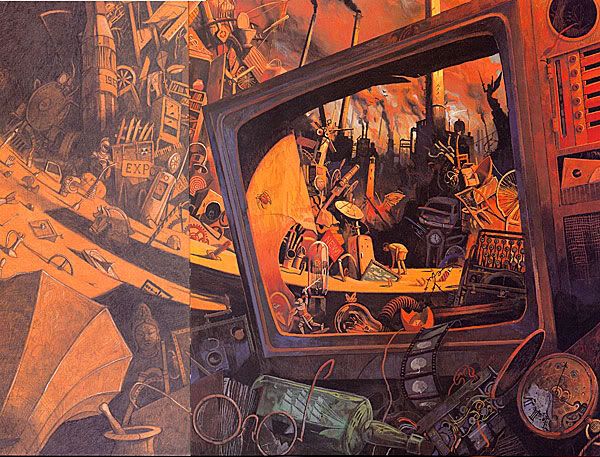Postmodern 'rubbish'?!!

This image is in Shaun Tan's picture book (a postmodern text) The Viewer.
Postmodern picture books provide teachers and students with opportunities to fully engage in the process of reading both literal texts and visual images.
Recently Australia's prime minister called upon a return to the 'classics' when it comes to teaching and learning about English in secondary schools. The Australian newspaper (May 13, 2006) asserted that "JOHN Howard believes the postmodern approach to literature being taught in schools is "rubbish" and is considering tying education funding to ending the "gobbledegook" taught in some states.
The Prime Minister made the threat after accusing the state education authorities of "dumbing down" the English syllabus and succumbing to political correctness.
"I feel very, very strongly about the criticism that many people are making that we are dumbing down the English syllabus," Mr Howard said."
The NSW English Syllabus for Stages 4, 5 and 6 has not been dumbed down. If Mr Howard, and his advisors, spent some time exploring both the syllabus documents and suggested texts they would find that there are, listed within the suggested texts, a range of texts from the 'classics' as well as texts from other times and cultures. The notion that the English syllabus is dumb is preposterous. The content of the courses is rigorous and the postmodern 'rubbish' of which the prime minister speaks is only a part of the whole English curriculum.
It is also apparent that the Prime Minister has failed to recognise that postmodernism rejects the universalising tendencies of philosophy. Instead of suggesting that there are universal truths embedded within a piece of literature it suggests that several perspectives can be attributed to every text; far more inclusive in our multi-cultural society.
Postmodernism (PoMo) uses the old, the new, art, commerical images and appropriated images and texts (from the 'classics') to create new texts.
As a teacher of English postmodern picture provide avenues through which real learning and critical thinking can explored. Making connections between and within texts provides a far more meaningful and interesting range of possiblities for a secondary English classroom and has very little to do with political correctness. Postmodernism, as a part of the study of English, is not rubbish!
If you're interested in checking out how postmodernism and picture books can be used in teaching and learning, for senior secondary school students, go to this webquest.
Feedback on how it works in the classroom will be appreciated.
